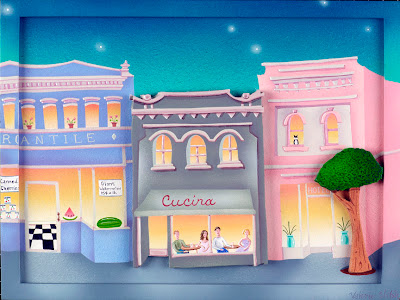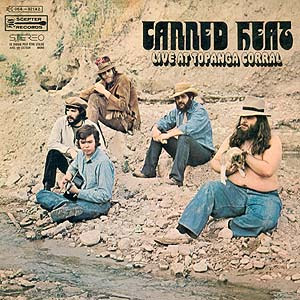
My submission for Illustration Friday's "canned" is a layered dimensional painting of a little town called Red Bluff, CA. It reminds me of childhood and small town life. Notice there are canned cherries in the window :)

This is a poster from my husband John Hartmann's concert hall "The Kaleidoscope" and you can see the Jefferson Airplane,Grateful Dead and Canned Heat played 3 consecutive nights in 1967. John's friend Gary Essert disovered them playing in a fraternity house where they were a huge hit. So John and his partner Skip Taylor signed the band on the UCLA campus. Skip still manages the band to this very day. Bob "The Bear" Hite lived in Topanga as well as "The Blind Owl" aka Allan Wilson. They played at the old Corral in Topanga.  If you have a moment please watch this gem of a short film and you will have a better day :) click on to the link "The Story of a Sign" Oddly a tin can is featured in this short.http://en.zappinternet.com/video/nilSqaMboM/HISTORIA-DE-UN-LETRERO-THE-STORY
If you have a moment please watch this gem of a short film and you will have a better day :) click on to the link "The Story of a Sign" Oddly a tin can is featured in this short.http://en.zappinternet.com/video/nilSqaMboM/HISTORIA-DE-UN-LETRERO-THE-STORY
I frequently do a workshop for teachers where I discuss, among other things, different elements good nonfiction may have, including plot or story. To illustrate this particular point, I bring out The Red-Eyed Tree Frog by Joy Cowley and Nic Bishop. Cowley’s book tells young readers where these frogs live, what they do and eat. But, with just 170 words, she also duplicates the structure of War and Peace. Okay, a little hyperbole here, there’s no Russian winter or love interest in this one, but the book does have a strong setting, a gutsy hero with a conflict, a subplot that leads to the climax, resolution of the original conflict, and a denouement.
So I was surprised the first time—and the second and third—when a teacher said he or she hadn’t realized that The Red-Eyed Tree Frog contained a full story.
Kids know this on some level, that’s why they read and reread the book. Humans are social creatures and busybodies; we all love to hear stories. I realized this in a past life, when I was a magazine writer. I’d write an article about, say, the effect of stress on infertility. Naturally I’d quote statistics and experts, but what people remembered were the anecdotes about Jane or Sarah’s experience. Stories are, in large part, how we learn.
Some nonfiction books are obvious stories, from Jennifer Armstrong’s account of Shackleton’s amazing Antarctic expedition, Shipwreck at the Bottom of the World to The Great Fire by Jim Murphy. Others are not so obvious. I’m not suggesting that writers should turn every animal into a swashbuckler or start giving thunderbolts a mission. I just know that when I’m writing and confused about how to proceed, I often ask myself, “What’s the story here?” And my answer may unlock the logjam.
A few years ago, I got a dream assignment. The new director of Selby Botanical Gardens in Sarasota, Florida, knew my children’s books and asked me to create new signage for the entire garden. I knew I could write clear, even lyric signs, but I wanted something more compelling. Now, Selby has a big sign at its entrance that explains that plants live their lives differently than we do, but they have the same needs and goals. Then I invited the visitor to come learn (through subsequent signs) about this world whose inhabitants were busy staying healthy, making a living and a family, fighting turf wars with neighbors, outfoxing predators—and, sometimes preying on others themselves. In other words, I made a story.
And a bookish example. My newest comes out in May--
See How They Run: Campaign Dreams, Election Schemes, and the Race to the White House.. In it, I write that we not only should vote, we also have to know enough to make good decisions. But what will kids remember more—that clear, slightly stodgy sentence or the story that follows it and illustrates the same idea, the one that took place in Milton, Washington, when Boston Curtis won an election in 1938. Milton’s mayor had put this totally unknown candidate on the ballot to prove how important it is to know who you are voting for. Boston Curtis was a mule.

 If you have a moment please watch this gem of a short film and you will have a better day :) click on to the link "The Story of a Sign" Oddly a tin can is featured in this short.
If you have a moment please watch this gem of a short film and you will have a better day :) click on to the link "The Story of a Sign" Oddly a tin can is featured in this short.



These little storefronts are so sweet and cheery. Love them, thanks for sharing.
I went up the country once, it was hot, but I got back late and almost got canned. Love Bad Dog
Val, gal...this looks like a lovely place to visit, canned or not!
Happy weekend!
www.indigeneartforms.blogspot.com
Nice use of Canned Heat!! :)
The video is incredible, just incredible. This man's "can" got full due to the beautiful message!
Great for Alejandro Monteverde can do... also handsome...
Thanks Valerie for your sense of touch and perception! Just beautiful...
You made my day!
Have a great weekend :)
you always have such wonderful posts!
What an incredible post. I love the way you pulled all the "cans" together, and we see yet another glimpse into Val's interesting life.
Fun stuff!!
ValGal, I will can this post so I can open it again. Hehe. I cannot see the movie. Anyhow you and your husband are such innovators, recognizing talent early on. I love cherries especially on top of cool whip over something sweet.
The sad music is still on.
Very sweet image! :)
Oh my gosh! I am so glad I tried again. I could not open it before (did not read instructions well. What a touching movie. Incredible the effecys of words and how they are said or used.
what a beautiful little town...I always know you'll have such a treat to share.
I love this little town you've illustrated...all the little details and the kitty looking out the window. BEAUTIFUL!
I just adore your dimensional paintings! I study them with awe. You have so many great postings for the theme this week!
very fun post. I bet it took cans of paint to paint those painted ladies (victorian)? Got a chuckle out of your canned heat album. I have a canned wheat in my album collection (the guess who) - which I recently pulled out of the dark recesses of my closet. As I recall the guess who pulled this album together in response to the canned heat music. I am going to take this as a sign to listen to canned wheat this weekend
http://en.wikipedia.org/wiki/Canned_Wheat
I've never been Red Bluff before. Looks like a really nice place! The town looks really serene. I like the cat! Heh!
Such a nice illustration! Love the pastel colors and light source...it seems to be twilight, my favorite time of day!
Val, your posts are truly inspiring! Not only for your beautiful illustrations but also for the little stories you share. It really made my day to see that video! =)
Great artwork and nice video. What a nice combination! Thanks for the video link. I shared it with friends.
This is wonderful, Val! Nice music selection BTW!
This is wonderful, Val! Nice music selection BTW!
this is so american looking...seeing it with my british eyes!nice one.
Thanks for the memories of Canned Heat!
Visit your blog is always a pleasure.
Arrivederci,
Cata
Lovely colors, I'm smiling.
I have some Canned Heat on tape somewhere around here... love that song.
I also love canned cherries-- esp. in mountain pies.:9
Great picture!
Delightful storefront, love canned cherries!!!
I love your special colours - and thanks for your comment and the music - it's music i heard when I was young - - -
Another gem from Val's World. Love Canned Heat too. I'm jiggling along to this ....
A dreamy town with building in pastel tone! Looovely!
wow! wow! WOW!
I want to live there!
OMG Canned Heat! Wonderful and clever of you to feature them in this post. Love your little town. I would love to open up a can of cherries in that little cucina.
The short put a glistening to my eyes. Thanks, what a cool post!
Thanks for your kind words in my blog Valerie.. I really appreciate them.. and I am going to clik in the link right now to see the video.. =)
Nice effect...would be nice to see one go 5 or 6 layers deep...
CANNED HEAT! ohmygoshh!!!! just lookit that cover. that is an amazingly cool thing to read, and it happened right there, in his concert hall.
sweet and lovely lil town piece, too, vallie. i see the cherries! :))
A beautiful piece Val and how nice that those canned cherries were in the window!
Wonderful illustration, texture, color, concept...all of it!
Canned cherries make the BEST pies!
Your work is always so cute and well put together. I love the depth and textures; and the cute buildings that always seem so happy.
Tony
Excellent work Val-now I see it. Great, informative post too btw!
Ciao Val stell me, is it a tray?